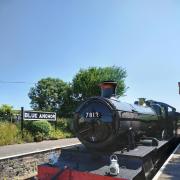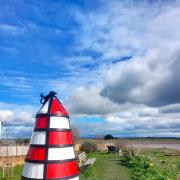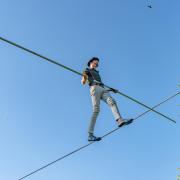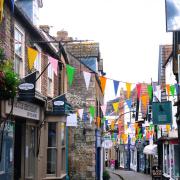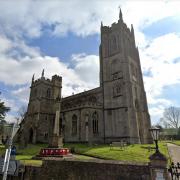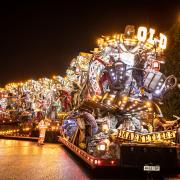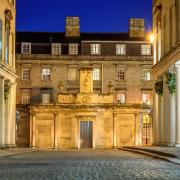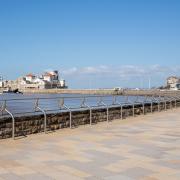Steve Roberts traces the trials and tribulations behind the construction of a famous Bristol landmark

Are the greatest sights natural or man-made? Perhaps the best come where man adds his own structure to a vista the planet’s forces had previously created without help from mortal man. The juxtaposition of human engineering and nature’s sculpting can sometimes be just breathtaking.
The Clifton Suspension Bridge has been in situ long enough that it seems an intrinsic part of its environment, as though it has always been there. It opened in 1864, so well over 150 years ago now. The bridge spans the River Avon and the Avon Gorge, but spectacularly, with wonderful views to be had for both pedestrians and motorists (if you’re driving though, please watch where you’re going!)
The start of my love affair with a bridge came a few years ago when my wife and I visited Bristol for a long weekend and came to Clifton on a beautiful sunny morning, when we saw the bridge at its best with blue sky and the sun glistening on the Avon’s waters. I find that love can take many forms. In this part of the world that is so redolent of Isambard Kingdom Brunel (1806-59), the bridge just had to be one of his constructions and is today a Grade I-listed structure.
There had been a stone bridge over the Avon as long ago as the 13th century, but any further crossing was hampered by the need for the bridge to be 100ft above the water to allow tall-masted ships through. This requirement spawned the idea of building at the Avon Gorge’s narrowest point. The first seed to be planted was in 1753 when Bristol wine merchant Alderman William Vick left a sum in his will, the intention being that the money be used for a stone bridge in this place.

It took until 1829 for a competition to be held to find a suitable design. There were 22 entries submitted, including four from Brunel, which suggests an approach akin to chucking mud at a garage door. The entries were whittled down to five (including one from Brunel), all of which were rejected by Scottish civil engineer Thomas Telford, who believed a single span was impossible. He was then invited to produce his own design, which he was no doubt only too pleased to do. Brunel, meanwhile, ‘smoked away his anger’, as one biographer put it: it sounds like he had clouds of steam billowing out of his ears.
Telford’s design did not win over the denizens of Bristol, however, which led to a second competition and ultimately a second chance for Brunel who persuaded the judges that his design was better than the Smith & Hawkes one they had already declared the winner. In the 24-year-old Brunel’s world there was clearly no such thing as a lost cause. Brunel would probably have felt it rather poetic that Telford’s own entry proved a non-runner due to cost. This was to be Brunel’s first major commission.
Construction was due to start in 1831 but, in the event, a five-year delay ensued due to political rioting in Bristol, which broke out after the House of Lords rejected the 2nd Parliamentary Reform Bill. The delay was very unfortunate for Brunel for a variety of reasons, not least because he would inconveniently die in 1859, thereby failing to see the completion of his bridge, by pretty much that same time-period (five years). The work also came to a grinding halt in 1853 when the funds ran out and it would not be until about a year after Brunel’s death that work on the bridge’s superstructure began. It seems Brunel’s death acted as a catalyst for the bridge’s completion, which was viewed as a fitting memorial to the great man.
In 1860 Brunel’s bridge over the Thames at Hungerford was demolished to make way for a new railway bridge and its chains were purchased for re-use on the Clifton Suspension Bridge. Stress testing was paramount, and this was achieved by spreading 500 tons of stone over it, without any adverse effect. The construction work was finally completed in 1864, all of 111 years after a bridge in this spot had first been proposed and 33 years after the work was first due to have started. Considering that close on 100 ‘navvies’ were killed in the construction of Brunel’s Box Tunnel, it is extraordinary really that only two workmen died during the bridge’s lengthy construction.

From either end of the bridge, from further up the gorge, or from below, which we reached via a zigzag path, the bridge’s construction can be admired. There are two bridge towers, 86ft above the car ‘deck’, and three independent wrought iron chains, which pass through these towers before being anchored in tunnels in the rocks 60ft below ground level at the sides of the gorge. The bridge deck itself is suspended from these chains by 81 matching wrought iron rods, which vary in length from 65ft at the bridge’s edge to 3ft at its centre. The bridge is no trifling matter, weighing around 1,500 tons, being 1,352ft long and sitting majestically 245ft above the river’s high-water level.
The bridge operates as a toll bridge with funds raised paying for its upkeep and over four million vehicles per year cross this Victorian gem today. Considering the bridge was designed for light horse-drawn traffic, it does well. A £1.9 million visitor centre opened at the Leigh Woods end of the bridge in 2015, which includes an exhibition, education space and shop.
We completed our visit those years ago by exploring the observatory with its camera obscura and then heading into Clifton Village for lunch. I was back this year to fraternise the visitor centre for the first time and reacquaint myself with an awe-inspiring bridge that has been described as, “Bristol’s ornament”. Just like an ornament in the home, its situation has been established to best effect. It is all very much as Mr Brunel intended.
Although the famous engineer did not live to see the Clifton Suspension Bridge completed there is no doubting its significance to his life story, as he always regarded it as his first child. The Clifton Bridge competition gave him the chance in life he needed, and all his subsequent achievement was attributed by him to this one signal success that he fought so tenaciously for. He never forgot the debt he owed to Bristol.
Things to see and do:
• Talk a walk across the bridge with your camera.
• Call in at the visitor centre (free admission), including its shop.
• Head for the Coffee Cart for refreshments during the summer season.
• Join one of the free tours (Saturdays and Sundays, May to October, from Clifton Toll Booth).
• Download the Bridge Tales app or try the audio trail.
• Fun activities for the children, including labelling parts of the bridge on a 3D magnetic map.
• Admire the bridge illuminations (each night from half an hour before sunset).
• Visit the Clifton Observatory, Camera Obscura and Cave, with superb views of the bridge.
• Try out the new café at the Observatory.
For more information, visit the Clifton Suspension Bridge website




